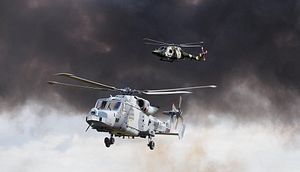South Korea’s Defense Acquisition Program Administration (DAPA) in May has issued a tender for the procurement of a second batch of anti-submarine warfare (ASW) helicopters for the Republic of Korea Navy (ROKN), according to local media reports.
The Request for Proposals (RFP) is expected to run from May 2 until August 16 with two firms, U.S. aerospace and defense company, Lockheed Martin, and Anglo-Italian defense contractor, Leonardo-Finmeccanica, set to compete for the $804 million contract.
“The companies’ proposals shall first be evaluated to select the eligible entities,” DAPA said in its announcement of the RFP. “DAPA will then conduct a test and evaluation, and negotiations on the selected systems.”
The recently issued tender is part of a larger plan–known as the Maritime Operational Helicopter program–to procure a total of 20 new anti-submarine warfare helicopters by 2022.
Back in 2018, DAPA issued two RFPs for the 12 helicopters with only Leonardo-Finmeccanica responding to the tender. However, after the official deadline for the second RFP passed, the U.S. government offered Lockheed Martin’s MH-60R Seahawk helicopter under a Foreign Military Sales (FMS) deal.
Leonardo-Finmeccanica will pitch its AgustaWestland AW Wildcat 159 shipborne ASW helicopter, according to the company.
“AW-159 is an industry-leading maritime operations helicopter with superior agility that has already proven its capabilities countering the submarine threat in the region with maritime operational helicopter batch 1 program,” a spokesman was quoted as saying by The Korea Times.
“Lockheed Martin will support the U.S. Navy’s efforts as they evaluate South Korea’s Maritime Operational Helicopter Batch 2 Request for Proposal. An FMS procurement of the MH-60R would expeditiously provide the South Korean Navy with the world’s most advanced anti-submarine and anti-surface warfare rotary-winged aircraft in the world,” Lockheed Martin said in a statement to The Korea Times.
The ROKN currently operates eight AW-159 Lynx Wildcat helicopters with the last batch of four entering service in July 2017. Notably, AW-159 helicopter outperformed the U.S.-made MH-60R Seahawk helicopter during trials in 2012 and the ROKN has so far been broadly satisfied with the helicopter’s operational performance. The AW-159 is also significantly cheaper than the MH-60R.
Armed with Spike NLOS missiles, K745 Cheong Sangeo (Blue Shark) light-weight torpedoes and depth charges, the AW-159 carries a Selex Seaspray 7000E active electronically scanned array radar and a Thales Compact FLASH Sonics low-frequency, long-range dipping sonar system for the detection of submarines.
MH-60R helicopters can carry AGM-114 Hellfires for use against surface and land targets, and MK 54 torpedoes for ASW missions. They can also be armed with APKWS 70mm laser-guided rockets. The helicopter features a APS-153(V) Multi-Mode radar system and and an airborne active low frequency sonar, next to other submarine detection technology.
“The new helicopters will be stationed aboard Incheon-class guided-missile frigates,” I explained previously. “The ROK Navy currently operates six vessels of the class and expects to commission 12 to 18 more in the coming years. The frigates are fitted with a flight deck and a hangar that can accommodate one ASW helicopter.”

































